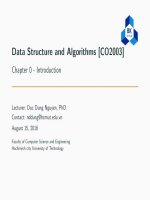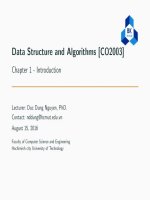C++ programming program design including data structure 7th ch05
Bạn đang xem bản rút gọn của tài liệu. Xem và tải ngay bản đầy đủ của tài liệu tại đây (692.47 KB, 51 trang )
Chapter 5:
Control Structures II (Repetition)
Objectives
•
In this chapter, you will:
–
–
–
–
–
Learn about repetition (looping) control structures
Learn how to use a while loop in a program
Explore how to construct and use counter-controlled, sentinel-controlled, flag-controlled, and EOFcontrolled repetition structures
Learn how to use a for loop in a program
Learn how to use a do…while loop in a program
C++ Programming: Program Design Including Data Structures, Seventh Edition
2
Objectives (cont’d.)
–
–
–
–
Examine break and continue statements
Discover how to form and use nested control structures
Learn how to avoid bugs by avoiding patches
Learn how to debug loops
C++ Programming: Program Design Including Data Structures, Seventh Edition
3
Why Is Repetition Needed?
•
Repetition allows efficient use of variables
•
Can input, add, and average multiple numbers using
a limited number of variables
•
For example, to add five numbers:
–
–
Declare a variable for each number, input the numbers and add the variables together
Create a loop that reads a number into a variable and adds it to a variable that contains the sum of
the numbers
C++ Programming: Program Design Including Data Structures, Seventh Edition
4
while Looping (Repetition) Structure
•
Syntax of the while statement:
•
statement can be simple or compound
•
expression acts as a decision maker and is usually
a logical expression
•
statement is called the body of the loop
•
The parentheses are part of the syntax
C++ Programming: Program Design Including Data Structures, Seventh Edition
5
while Looping (Repetition) Structure
(cont’d.)
C++ Programming: Program Design Including Data Structures, Seventh Edition
6
while Looping (Repetition) Structure
(cont’d.)
C++ Programming: Program Design Including Data Structures, Seventh Edition
7
while Looping (Repetition) Structure
(cont’d.)
•
The variable i in Example 5-1 is called the loop
control variable (LCV)
•
Infinite loop: continues to execute endlessly
–
Avoided by including statements in loop body that assure the exit condition is eventually false
C++ Programming: Program Design Including Data Structures, Seventh Edition
8
while Looping (Repetition) Structure
(cont’d.)
C++ Programming: Program Design Including Data Structures, Seventh Edition
9
Case 1: Counter-Controlled while
Loops
•
When you know exactly how many times the
statements need to be executed
–
Use a counter-controlled while loop
C++ Programming: Program Design Including Data Structures, Seventh Edition
10
Case 2: Sentinel-Controlled while
Loops
•
Sentinel variable is tested in the condition
•
Loop ends when sentinel is encountered
C++ Programming: Program Design Including Data Structures, Seventh Edition
11
Example 5-5: Telephone Digits
•
Example 5-5 provides an example of a sentinelcontrolled loop
•
The program converts uppercase letters to their
corresponding telephone digit
C++ Programming: Program Design Including Data Structures, Seventh Edition
12
Case 3: Flag-Controlled while Loops
•
Flag-controlled while loop: uses a bool variable
to control the loop
C++ Programming: Program Design Including Data Structures, Seventh Edition
13
Number Guessing Game
•
Example 5-6 implements a number guessing game
using a flag-controlled while loop
•
Uses the function rand of the header file cstdlib
to generate a random number
–
–
rand() returns an int value between 0 and 32767
To convert to an integer >= 0 and < 100:
• rand() % 100
C++ Programming: Program Design Including Data Structures, Seventh Edition
14
Case 4: EOF-Controlled while Loops
•
End-of-file (EOF)-controlled while loop: when it
is difficult to select a sentinel value
•
The logical value returned by cin can determine if
there is no more input
C++ Programming: Program Design Including Data Structures, Seventh Edition
15
Case 4: EOF-Controlled while Loops
(cont’d.)
C++ Programming: Program Design Including Data Structures, Seventh Edition
16
eof Function
•
The function eof determines the end of file status
•
eof is a member of data type istream
•
Syntax for the function eof:
•
istreamVar is an input stream variable, such as
cin
C++ Programming: Program Design Including Data Structures, Seventh Edition
17
More on Expressions in while
Statements
•
The expression in a while statement can be complex
– Example:
while ((noOfGuesses < 5) && (!isGuessed))
{
. . .
}
C++ Programming: Program Design Including Data Structures, Seventh Edition
18
Programming Example: Fibonacci
Number
•
Consider the following sequence of numbers:
–
1, 1, 2, 3, 5, 8, 13, 21, 34, ....
•
Called the Fibonacci sequence
•
Given the first two numbers of the sequence (say,
a1 and a2)
–
n
th
number an, n >= 3, of this sequence is given by: an = an-1 + an-2
C++ Programming: Program Design Including Data Structures, Seventh Edition
19
Programming Example: Fibonacci
Number (cont’d.)
•
Fibonacci sequence
–
–
–
–
n
th
Fibonacci number
a2 = 1
a1 = 1
Determine the n
th
number an, n >= 3
C++ Programming: Program Design Including Data Structures, Seventh Edition
20
Programming Example: Fibonacci
Number (cont’d.)
•
Suppose a2 = 6 and a1 = 3
–
–
•
a3 = a2 + a1 = 6 + 3 = 9
a4 = a3 + a2 = 9 + 6 = 15
Write a program that determines the nth Fibonacci
number, given the first two numbers
C++ Programming: Program Design Including Data Structures, Seventh Edition
21
Programming Example: Input and
Output
•
Input: first two Fibonacci numbers and the desired
Fibonacci number
•
Output: nth Fibonacci number
C++ Programming: Program Design Including Data Structures, Seventh Edition
22
Programming Example: Problem
Analysis and Algorithm Design
•
Algorithm:
–
–
Get the first two Fibonacci numbers
Get the desired Fibonacci number
• Get the position, n, of the number in the sequence
–
Calculate the next Fibonacci number
• Add the previous two elements of the sequence
–
–
Repeat Step 3 until the n
Output the n
th
th
Fibonacci number is found
Fibonacci number
C++ Programming: Program Design Including Data Structures, Seventh Edition
23
Programming Example: Variables
C++ Programming: Program Design Including Data Structures, Seventh Edition
24
Programming Example: Main
Algorithm
•
Prompt the user for the first two numbers—that is,
previous1 and previous2
•
Read (input) the first two numbers into previous1
and previous2
•
Output the first two Fibonacci numbers
•
Prompt the user for the position of the desired
Fibonacci number
C++ Programming: Program Design Including Data Structures, Seventh Edition
25









